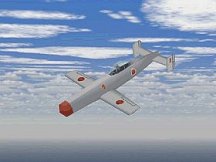 |
This model depicts a Yokosuka MXY7 Okha. The Okha was a
human-guided missile specifically designed to allow a pilot with rudimentary
training to crash himself at high speed into an Allied warship. To the Allies,
these units became known as Kamikaze, or suicide aircraft. The Japanese used
the word Tokko, or Special Attack. It is estimated that by the end of the war,
5,000 pilots had died making Tokko attacks. They flew almost every type of
Japanese military airplane but initial operations showed the need for an
aircraft designed and built specifically for this mission, and the Okha was the
product of this design. The Ohka's combat debut was on March 21, 1945, when
Gruman F6F Hellcats intercepted 16 Bettys carrying Ohkas. The entire group was
shot down, and most of the Okhas fell into the sea. Okhas were encountered
again at Okinawa in April/May 1945 in larger numbers, sinking at least one U.S.
destroyer and damaging several others.
This model and skin was created
by Charles, based on the EAW V1 flying
bomb.
(V1 Slot) |
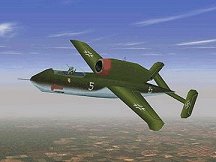 |
This model depicts a Heinkel He-162 Salamander. The
He-162 was conceived as a last-ditch fighter to be flown by unskilled pilots in
late 1944. The so-called Volksjaeger ("People's Fighter") was designed and
flown in only 10 weeks, and had its first flight on 6 December. Built from
readily-available materials (the wing was made of wood), it was a small and
relatively unsopisticated aircraft, although it did have an ejector seat,
because the position of the BMW turbojet engine would have otherwise made
bailing out a difficult proposition. The first version (the A1) had 2x30mm
cannon fitted, but excessive vibration when fired caused their replacement by
20mm MG151s in the main production version, the A2. Approximately 150 A2s were
accepted by the Luftwaffe, and it saw service with JG1. Some were encountered
operationally by Allied aircraft in 1945.
This model and skin was
created by Charles, based on the EAW V1
flying bomb. The instruments were enhanced by Angeleyes. The cockpit was based on the Ta183
cockpit by Mosi.
(ME-109E Slot) |
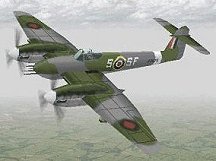 |
This model depicts a Westland Whirlwind Mk.1 of No.137
Squadron, RAF Circa 1943. A second scheme is available in colours of No.263
Squadron, RAF Circa 1941-42. The RAF's first twin-engined fighter, the Westland
Whirlwind entered service in July 1940, with No.263 Sqn. At low level the
Whirlwind had few equals for speed, but it was plagued by its unreliable
Rolls-Royce Peregrine engines. Only 112 were produced, and it equipped only two
squadrons (No's 263 and 137). With its concentrated battery of four 20mm cannon
in the nose and a bomb-load, the Whirlwind was widely used as a cross-Channel
raider in 1941-43. No.137 Sqn re-equipped with rocket-firing Hurricane IV's in
June 1943, and No.263 Sqn with Typhoons in December 1943.
This model and
skin was created by Charles, based on the
EAW Me.410 aircraft. The instruments were enhanced by Angeleyes. Editing was possible using
Alessandro's utilities, the Converter and
3DZ Studio and the 3DZMap and Scaler utilities of Paulo Morais.
(P-38H Slot) |
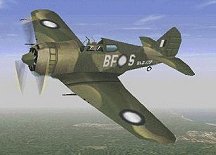 |
This model depicts a CAC Boomerang of No.5 Squadron,
RAAF, based in New Guinea in 1944. The CAC (Commonwealth Aircraft Corporation)
Boomerang was conceived as "panic fighter" in early 1942, when Australia was
under dire threat of Japanese invasion, and fighter aircraft were in short
supply. Produced entirely in Australia, the Boomerang first flew in May 1942,
only 16 weeks after design commenced. By the time it entered service in early
1943, however, sufficient quantities of the much-superior Spitfire and P40 were
available, and the Boomerang was relegated to a ground-support role.
Manoeuvrable, sturdy and well-armed, the Boomerang was operated by five RAAF
squadrons from 1943-45, in New Guinea and Bougainville, and gave sterling
service in the ground-support role.
This model and skin was created by
Charles, based on the Hawk 75 model by
Captain Kurt. The skin uses some textures
from Captain Kurt and Rpb Der Fuchs.
Editing was possible using Alessandro's
utilities, the Converter and 3DZ Studio.
(SPIT 1 Slot) |
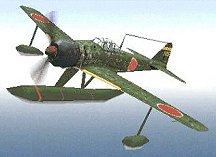 |
The 'Rufe' was a Mitsubishi A6M2 Zero, manufactured by
Nakajima as a floatplane to support the Japanese offensive in the Pacific. It
entered service during December 1941 and was widely used during 1942-43, in the
Solomons and the Aleutians. Although not as fast as the 'Zero' (270 mph
compared to the Zero's 331 mph), it did possess surprising manoeuvrability for
a floatplane. Several IJN pilots became aces flying the 'Rufe'.
The
original Zero shape from Microprose' Pacific Air War was adapted by Paulo Morais. The skin is by Jamie Richards. Changes to the aircraft shape,
adding the aerial and pitot tube, rounding the wingtips, adding the floats
(using Moggy's 3D overlay technique) and some changes to the skin were by
Charles.
(FW-190D Slot) |
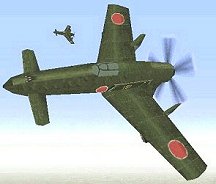 |
The Kyushu J7W1 Shinden ("Magnificent Lightning") was a
canard designed fighter, an unusual design which was intended for interceptor
duties against the Boeing B-29 'Super Fortress'. This particular colour scheme
is fictional and represents a late-War IJNAF aircraft.
This model was
created by Charles from the PAW P-39 shape,
and uses as a base a skin by Claudio
Wilches from Alessandro's Site
and is corrected for use in ECA Control Panel, version 3.6.
(FW-190D Slot) |
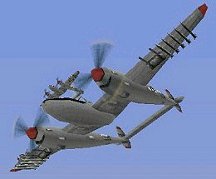 |
This model of a P-38L is based on the P-38J Lightning
"Marge" of American ace Richard Ira Bong, serving with the 5th AF, 49th Fighter
Group, 9th Fighter Squadron. This model provides for extra ordnance load
hardpoints, so rockets and/or .50 cal gun pods will show under the outer wings
(using ECA Control Panel, version 3.7 or later).
This model was created
by Charles from the original P-38J of
Airbuddha.
(P-38J Slot) |
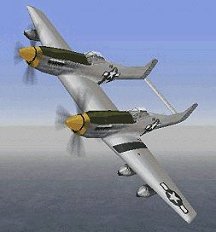 |
The P-82 Twin Mustang was designed in 1944, as an
ultra-long range escort fighter for both the European and Pacific theatres.
Although some had flown before VJ day, it saw no active service in WWII,
although saw active service in the Korean conflict. This aircraft had an
outstanding range on its internal fuel tanks alone, and could carry up to four
165-gallon external tanks, or up to four 1000lb bombs, or 25 HVAR
rockets.
This model was created by Charles from the original 361st FG P-51D Mustang of
Airbuddha. The 3D overlaying technique used
and the undercarriage fix were from
Moggy.
(P-51D
Slot) |
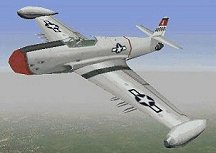 |
This aircraft represents a Lockheed P-80a Shooting Star
of the 56th Fighter Group during 1948.
This model was created by
Charles from his original P-80 model
released in July, 2000 and based on the PAW P-39 model. The aircraft skin was
created by Jeff 'Salty' Salter. The
transparent canopy, pilot and nose polygon fix were by Geo.
(P-51D
Slot) |
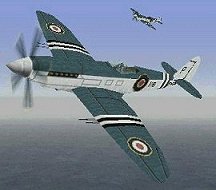 |
This aircraft represents a Supermarine Seafire Mk.47
which was developed for naval use from the land based Spitfire series.
The original Spitfire Mk.22 model used was created by Paulo Morais. The aircraft skin and changes to the
cockpit and engine cowling were by Charles.
(SPIT 14 Slot) |
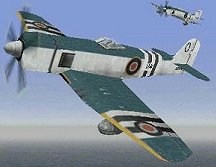 |
This model represents a Hawker Seafury Mk.10 from either
the Royal Navy (RN), Royal Australian Navy (RAN) or the Royal Canadian Navy
(RCN). In each case these are fictional, but do depict typical skins from
aircraft on active service in the late 1940's or early 1950's.
The
model and hangar screen were created by Charles. The aircraft skins were by Jamie Richards/Charles. The sharpened cockpit gauges
were created by Angeleyes and the hangar
screen stopper file was by -E. The
wide-view cockpit is by Jamie Richards.
(TEMP Slot) |
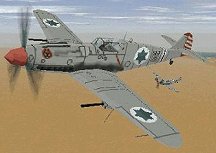 |
This model represents an Avia S.199 "Mule". The S.199
was the Messerschmitt (Bf) 109G, re-built during the post-War years by the
Czech Avia company. It was the first fighter of the Israeli Air Force, being
delivered in 1948.
This model was adapted by Charles using an original model and skin by Karl. The cockpit wide angle view was created by
JWC. The 3D overlaying technique was from
Moggy.
(TYPH Slot) |
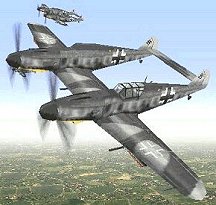 |
This model represents a Meserschmitt (Bf) 109Z1
'Zwilling', a twin boom version of the Bf 109 series of aircraft.
The
model was created by Charles, using the EAW
Bf 109G aircraft as a base. The original aircraft skin was by Mosi with some changes by Charles. The model-enhancements (such as air scoop
and aerials) were created by Capitan Manduca/Pretzel
. The 3D overlaying technique used was from Moggy.
(ME-109E
Slot) |
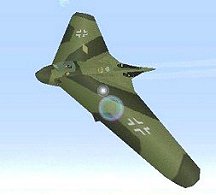 |
This model represents a Gotha Go-229A-1 (Horten Ho-IX
Flying Wing) jet interceptor. This aircraft never saw active service during
World War 2.
The model was created by Charles from the original EAW P-39 model and skin by
Claudio Wilches. The 3D cockpit views and
wing views used were from the Ta-183 model by Mosi. The camouflaged skin was from the
Messerschmitt 163 Komet skin of MK
Sheppard.
(ME-109G
Slot) |
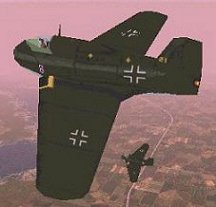 |
This model represents a Messerschmitt Me-163 Komet jet
interceptor. The actual aircraft saw limited active service during World War 2.
The model was created by Charles
from the original EAW P-39 model by Claudio
Wilches. The 3D cockpit views and wing views used were from the
Ta-183 model by Mosi.
(ME-109K Slot) |
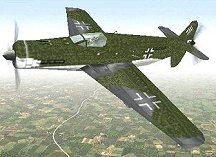 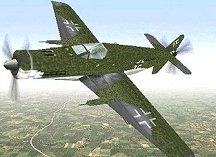 |
This model represents two camouflaged versions of a
Dornier Do-335 Pfeil 'Arrow', a heavy multi-role fighter. The colour scheme is
depicted is fictional and late-War.
This aircraft model was created by
Charles, made possible through the use of
the EAW utilities, Paulo's 3DZMAP.EXE and
Alessandro's 3DZ Studio and Converter. The
base model used was the EAW Focke-Wulf 190D with an aircraft skin by Paulo Morais.
(FW-190D Slot) |
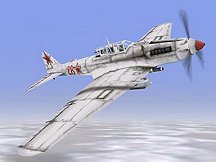 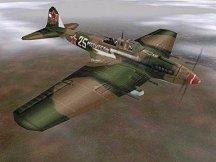 |
This model represents two camouflaged versions of a
Russian Il-2M3 Sturmovik.
This aircraft model was created by Charles from the original Il-2 model, which was
adapted from the PAW 'Kate' model by Charles/Woolfman. The 3D overlaying technique used
was from Moggy. Inspiration for the
non-mirrored panels for the fuselage and rudder, new cockpit wing-views, and
details like a wing-spar texture and torn-off wing stub were from the recently
revised Hellcat by Geo. The two aircraft
skin schemes were created by Steve
Day.
(P-47D Slot)
|